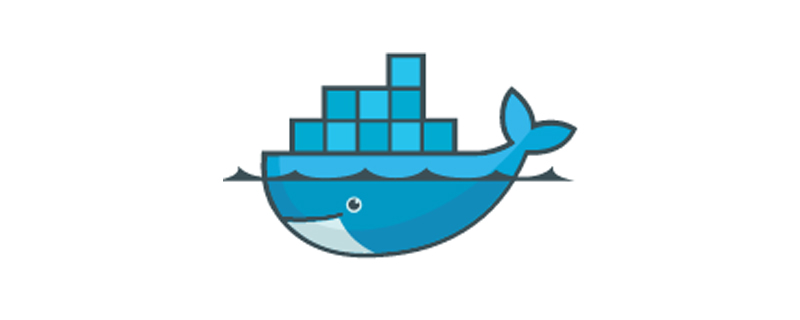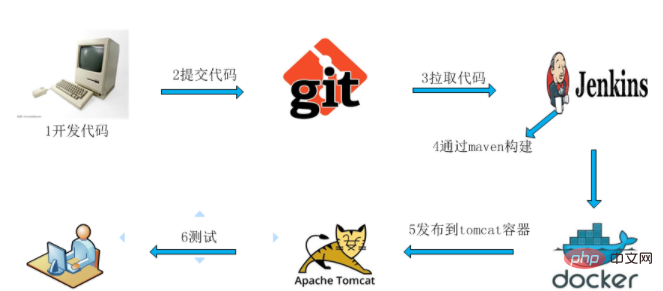What is the use of docker?
The role of docker: 1. Solve problems caused by inconsistent operating environments; 2. Limit the largest CPU to use memory hard disk, which plays an isolation role and avoids an infinite loop in a piece of code; 3. Can be used as an expansion machine use.

Recommended related articles: "What is docker"
Docker as A software containerization platform that allows developers to build applications, package them together with their dependent environments into a container, and then easily publish and apply them to any platform.
Recommendation: "docker video tutorial"
Docker function:
Resolve inconsistent operating environment problems caused. In this way, there will be no situation where "it runs fine locally, but it doesn't work once it's on the server."
Limit the largest CPU to use the memory hard disk, which plays a role in isolation and avoids "a piece of code creates an infinite loop, fills up the disk, and other programs also hang up" Condition.
Used to expand the machine during Double 11.

Here are a few cases to let everyone experience it.
Case 1
A few days ago, a batch of the company's servers was about to expire. Since the servers were purchased in 2015, the performance of the hardware was much newer than it is now. The cloud host is low, so I decided to replace all servers with new-generation servers. However, when the editor was preparing to migrate the servers, I felt a sense of collapse in my heart. After careful calculation, each server had to do the same thing:
Install jdk, Tomcat, nginx
Configure jdk environment variables and system variables
Configuration Tomcat
Configure nginx
Install the video decoding components required for the project
Import the project Later, I decided to use docker deployment method for some special fonts needed. After installing docker on each server, I only need to pull the Tomcat image from the mirror warehouse on one of the servers, set all these configurations, and make Upload a mirror of your own to the mirror warehouse, then download the mirror you made on several other servers, run it in docker, upload the code, and everything will be fine.
Case 2
During the Christmas event not long ago, the company’s temporary activity plan was finally launched after the programmers worked overtime, but after a while After going online, I found that the Chinese name in the promotion poster was garbled. The leader asked the testers why they didn't do a good job in testing. The tester was very aggrieved and said that I had tested countless times and submitted the test reports. I solved all the problems before going online; there was no way to just go online. Let the server colleagues check the tomcat configuration in the official server and find that tomcat uses the default encoding: iso8859-1, while the test environment is UTF-8. In response to this problem, the project team decided to migrate the development environment to docker. After testing in the test environment, the image was packaged and released to the formal environment, which solved the problems caused by different environments.
Recommended: "docker tutorial"
The above is the detailed content of What is the use of docker?. For more information, please follow other related articles on the PHP Chinese website!

Hot AI Tools

Undresser.AI Undress
AI-powered app for creating realistic nude photos

AI Clothes Remover
Online AI tool for removing clothes from photos.

Undress AI Tool
Undress images for free

Clothoff.io
AI clothes remover

Video Face Swap
Swap faces in any video effortlessly with our completely free AI face swap tool!

Hot Article

Hot Tools

Notepad++7.3.1
Easy-to-use and free code editor

SublimeText3 Chinese version
Chinese version, very easy to use

Zend Studio 13.0.1
Powerful PHP integrated development environment

Dreamweaver CS6
Visual web development tools

SublimeText3 Mac version
God-level code editing software (SublimeText3)

Hot Topics
 1386
1386
 52
52
 How to update the image of docker
Apr 15, 2025 pm 12:03 PM
How to update the image of docker
Apr 15, 2025 pm 12:03 PM
The steps to update a Docker image are as follows: Pull the latest image tag New image Delete the old image for a specific tag (optional) Restart the container (if needed)
 How to create a mirror in docker
Apr 15, 2025 am 11:27 AM
How to create a mirror in docker
Apr 15, 2025 am 11:27 AM
Steps to create a Docker image: Write a Dockerfile that contains the build instructions. Build the image in the terminal, using the docker build command. Tag the image and assign names and tags using the docker tag command.
 How to use docker desktop
Apr 15, 2025 am 11:45 AM
How to use docker desktop
Apr 15, 2025 am 11:45 AM
How to use Docker Desktop? Docker Desktop is a tool for running Docker containers on local machines. The steps to use include: 1. Install Docker Desktop; 2. Start Docker Desktop; 3. Create Docker image (using Dockerfile); 4. Build Docker image (using docker build); 5. Run Docker container (using docker run).
 How to save docker image
Apr 15, 2025 am 11:54 AM
How to save docker image
Apr 15, 2025 am 11:54 AM
To save the image in Docker, you can use the docker commit command to create a new image, containing the current state of the specified container, syntax: docker commit [Options] Container ID Image name. To save the image to the repository, you can use the docker push command, syntax: docker push image name [: tag]. To import saved images, you can use the docker pull command, syntax: docker pull image name [: tag].
 What to do if the docker image fails
Apr 15, 2025 am 11:21 AM
What to do if the docker image fails
Apr 15, 2025 am 11:21 AM
Troubleshooting steps for failed Docker image build: Check Dockerfile syntax and dependency version. Check if the build context contains the required source code and dependencies. View the build log for error details. Use the --target option to build a hierarchical phase to identify failure points. Make sure to use the latest version of Docker engine. Build the image with --t [image-name]:debug mode to debug the problem. Check disk space and make sure it is sufficient. Disable SELinux to prevent interference with the build process. Ask community platforms for help, provide Dockerfiles and build log descriptions for more specific suggestions.
 How to copy files in docker to outside
Apr 15, 2025 pm 12:12 PM
How to copy files in docker to outside
Apr 15, 2025 pm 12:12 PM
Methods for copying files to external hosts in Docker: Use the docker cp command: Execute docker cp [Options] <Container Path> <Host Path>. Using data volumes: Create a directory on the host, and use the -v parameter to mount the directory into the container when creating the container to achieve bidirectional file synchronization.
 How to exit the container by docker
Apr 15, 2025 pm 12:15 PM
How to exit the container by docker
Apr 15, 2025 pm 12:15 PM
Four ways to exit Docker container: Use Ctrl D in the container terminal Enter exit command in the container terminal Use docker stop <container_name> Command Use docker kill <container_name> command in the host terminal (force exit)
 How to check the name of the docker container
Apr 15, 2025 pm 12:21 PM
How to check the name of the docker container
Apr 15, 2025 pm 12:21 PM
You can query the Docker container name by following the steps: List all containers (docker ps). Filter the container list (using the grep command). Gets the container name (located in the "NAMES" column).




